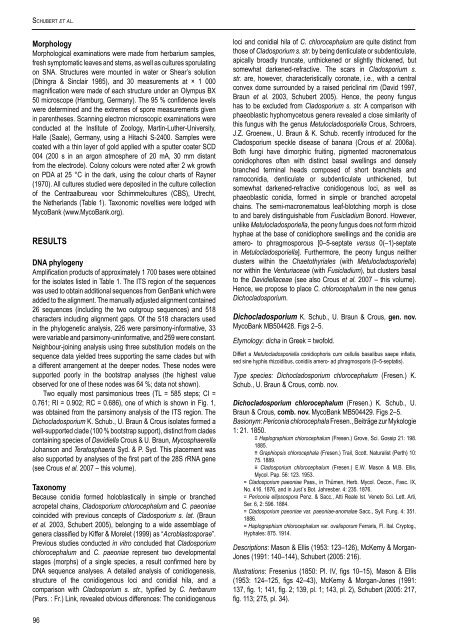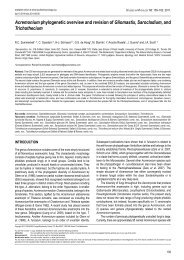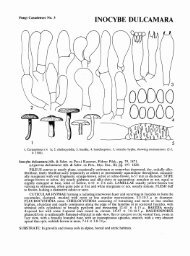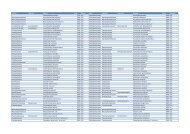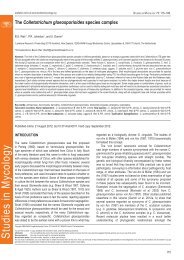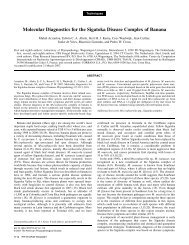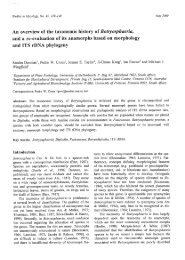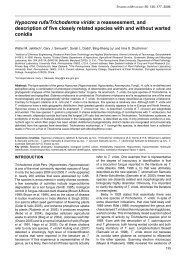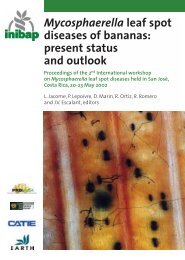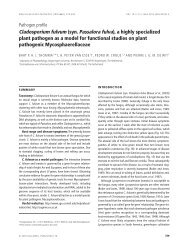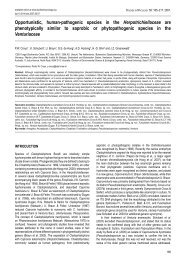Cladosporium leaf-blotch and stem rot of Paeonia spp. caused ... - Cbs
Cladosporium leaf-blotch and stem rot of Paeonia spp. caused ... - Cbs
Cladosporium leaf-blotch and stem rot of Paeonia spp. caused ... - Cbs
Create successful ePaper yourself
Turn your PDF publications into a flip-book with our unique Google optimized e-Paper software.
Schubert et al.<br />
Morphology<br />
Morphological examinations were made from herbarium samples,<br />
fresh symptomatic leaves <strong>and</strong> <strong>stem</strong>s, as well as cultures sporulating<br />
on SNA. Structures were mounted in water or Shear’s solution<br />
(Dhingra & Sinclair 1985), <strong>and</strong> 30 measurements at × 1 000<br />
magnification were made <strong>of</strong> each structure under an Olympus BX<br />
50 microscope (Hamburg, Germany). The 95 % confidence levels<br />
were determined <strong>and</strong> the extremes <strong>of</strong> spore measurements given<br />
in parentheses. Scanning electron microscopic examinations were<br />
conducted at the Institute <strong>of</strong> Zoology, Martin-Luther-University,<br />
Halle (Saale), Germany, using a Hitachi S-2400. Samples were<br />
coated with a thin layer <strong>of</strong> gold applied with a sputter coater SCD<br />
004 (200 s in an argon atmosphere <strong>of</strong> 20 mA, 30 mm distant<br />
from the electrode). Colony colours were noted after 2 wk growth<br />
on PDA at 25 °C in the dark, using the colour charts <strong>of</strong> Rayner<br />
(1970). All cultures studied were deposited in the culture collection<br />
<strong>of</strong> the Centraalbureau voor Schimmelcultures (CBS), Utrecht,<br />
the Netherl<strong>and</strong>s (Table 1). Taxonomic novelties were lodged with<br />
MycoBank (www.MycoBank.org).<br />
resulTs<br />
dnA phylogeny<br />
Amplification products <strong>of</strong> approximately 1 700 bases were obtained<br />
for the isolates listed in Table 1. The ITS region <strong>of</strong> the sequences<br />
was used to obtain additional sequences from GenBank which were<br />
added to the alignment. The manually adjusted alignment contained<br />
26 sequences (including the two outgroup sequences) <strong>and</strong> 518<br />
characters including alignment gaps. Of the 518 characters used<br />
in the phylogenetic analysis, 226 were parsimony-informative, 33<br />
were variable <strong>and</strong> parsimony-uninformative, <strong>and</strong> 259 were constant.<br />
Neighbour-joining analysis using three substitution models on the<br />
sequence data yielded trees supporting the same clades but with<br />
a different arrangement at the deeper nodes. These nodes were<br />
supported poorly in the bootstrap analyses (the highest value<br />
observed for one <strong>of</strong> these nodes was 64 %; data not shown).<br />
Two equally most parsimonious trees (TL = 585 steps; CI =<br />
0.761; RI = 0.902; RC = 0.686), one <strong>of</strong> which is shown in Fig. 1,<br />
was obtained from the parsimony analysis <strong>of</strong> the ITS region. The<br />
Dichocladosporium K. Schub., U. Braun & Crous isolates formed a<br />
well-supported clade (100 % bootstrap support), distinct from clades<br />
containing species <strong>of</strong> Davidiella Crous & U. Braun, Mycosphaerella<br />
Johanson <strong>and</strong> Teratosphaeria Syd. & P. Syd. This placement was<br />
also supported by analyses <strong>of</strong> the first part <strong>of</strong> the 28S rRNA gene<br />
(see Crous et al. 2007 – this volume).<br />
Taxonomy<br />
Because conidia formed holoblastically in simple or branched<br />
acropetal chains, <strong>Cladosporium</strong> chlorocephalum <strong>and</strong> C. paeoniae<br />
coincided with previous concepts <strong>of</strong> <strong>Cladosporium</strong> s. lat. (Braun<br />
et al. 2003, Schubert 2005), belonging to a wide assemblage <strong>of</strong><br />
genera classified by Kiffer & Morelet (1999) as “Acroblastosporae”.<br />
Previous studies conducted in vitro concluded that <strong>Cladosporium</strong><br />
chlorocephalum <strong>and</strong> C. paeoniae represent two developmental<br />
stages (morphs) <strong>of</strong> a single species, a result confirmed here by<br />
DNA sequence analyses. A detailed analysis <strong>of</strong> conidiogenesis,<br />
structure <strong>of</strong> the conidiogenous loci <strong>and</strong> conidial hila, <strong>and</strong> a<br />
comparison with <strong>Cladosporium</strong> s. str., typified by C. herbarum<br />
(Pers. : Fr.) Link, revealed obvious differences: The conidiogenous<br />
96<br />
loci <strong>and</strong> conidial hila <strong>of</strong> C. chlorocephalum are quite distinct from<br />
those <strong>of</strong> <strong>Cladosporium</strong> s. str. by being denticulate or subdenticulate,<br />
apically broadly truncate, unthickened or slightly thickened, but<br />
somewhat darkened-refractive. The scars in <strong>Cladosporium</strong> s.<br />
str. are, however, characteristically coronate, i.e., with a central<br />
convex dome surrounded by a raised periclinal rim (David 1997,<br />
Braun et al. 2003, Schubert 2005). Hence, the peony fungus<br />
has to be excluded from <strong>Cladosporium</strong> s. str. A comparison with<br />
phaeoblastic hyphomycetous genera revealed a close similarity <strong>of</strong><br />
this fungus with the genus Metulocladosporiella Crous, Schroers,<br />
J.Z. Groenew., U. Braun & K. Schub. recently introduced for the<br />
<strong>Cladosporium</strong> speckle disease <strong>of</strong> banana (Crous et al. 2006a).<br />
Both fungi have dimorphic fruiting, pigmented macronematous<br />
conidiophores <strong>of</strong>ten with distinct basal swellings <strong>and</strong> densely<br />
branched terminal heads composed <strong>of</strong> short branchlets <strong>and</strong><br />
ramoconidia, denticulate or subdenticulate unthickened, but<br />
somewhat darkened-refractive conidiogenous loci, as well as<br />
phaeoblastic conidia, formed in simple or branched acropetal<br />
chains. The semi-macronematous <strong>leaf</strong>-<strong>blotch</strong>ing morph is close<br />
to <strong>and</strong> barely distinguishable from Fusicladium Bonord. However,<br />
unlike Metulocladosporiella, the peony fungus does not form rhizoid<br />
hyphae at the base <strong>of</strong> conidiophore swellings <strong>and</strong> the conidia are<br />
amero- to phragmosporous [0–5-septate versus 0(–1)-septate<br />
in Metulocladosporiella]. Furthermore, the peony fungus neither<br />
clusters within the Chaetothyriales (with Metulocladosporiella)<br />
nor within the Venturiaceae (with Fusicladium), but clusters basal<br />
to the Davidiellaceae (see also Crous et al. 2007 – this volume).<br />
Hence, we propose to place C. chlorocephalum in the new genus<br />
Dichocladosporium.<br />
Dichocladosporium K. Schub., U. Braun & Crous, gen. nov.<br />
MycoBank MB504428. Figs 2–5.<br />
Etymology: dicha in Greek = tw<strong>of</strong>old.<br />
Differt a Metulocladosporiella conidiophoris cum cellulis basalibus saepe inflatis,<br />
sed sine hyphis rhizoidibus, conidiis amero- ad phragmosporis (0–5-septatis).<br />
Type species: Dichocladosporium chlorocephalum (Fresen.) K.<br />
Schub., U. Braun & Crous, comb. nov.<br />
Dichocladosporium chlorocephalum (Fresen.) K. Schub., U.<br />
Braun & Crous, comb. nov. MycoBank MB504429. Figs 2–5.<br />
Basionym: Periconia chlorocephala Fresen., Beiträge zur Mykologie<br />
1: 21. 1850.<br />
≡ Haplographium chlorocephalum (Fresen.) Grove, Sci. Gossip 21: 198.<br />
1885.<br />
≡ Graphiopsis chlorocephala (Fresen.) Trail, Scott. Naturalist (Perth) 10:<br />
75. 1889.<br />
≡ <strong>Cladosporium</strong> chlorocephalum (Fresen.) E.W. Mason & M.B. Ellis,<br />
Mycol. Pap. 56: 123. 1953.<br />
= <strong>Cladosporium</strong> paeoniae Pass., in Thümen, Herb. Mycol. Oecon., Fasc. IX,<br />
No. 416. 1876, <strong>and</strong> in Just´s Bot. Jahresber. 4: 235. 1876.<br />
= Periconia ellipsospora Penz. & Sacc., Atti Reale Ist. Veneto Sci. Lett. Arti,<br />
Ser. 6, 2: 596. 1884.<br />
= <strong>Cladosporium</strong> paeoniae var. paeoniae-anomalae Sacc., Syll. Fung. 4: 351.<br />
1886.<br />
= Haplographium chlorocephalum var. ovalisporum Ferraris, Fl. Ital. Cryptog.,<br />
Hyphales: 875. 1914.<br />
Descriptions: Mason & Ellis (1953: 123–126), McKemy & Morgan-<br />
Jones (1991: 140–144), Schubert (2005: 216).<br />
Illustrations: Fresenius (1850: Pl. IV, figs 10–15), Mason & Ellis<br />
(1953: 124–125, figs 42–43), McKemy & Morgan-Jones (1991:<br />
137, fig. 1; 141, fig. 2; 139, pl. 1; 143, pl. 2), Schubert (2005: 217,<br />
fig. 113; 275, pl. 34).


